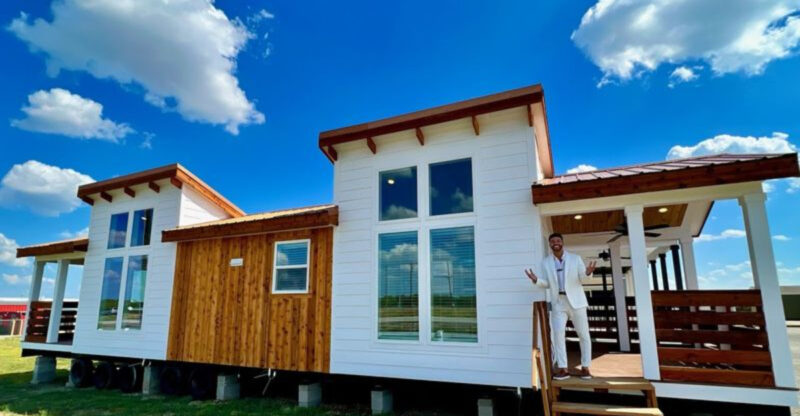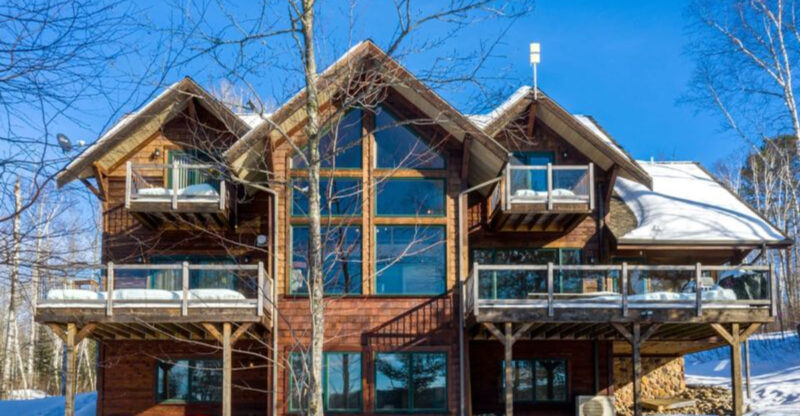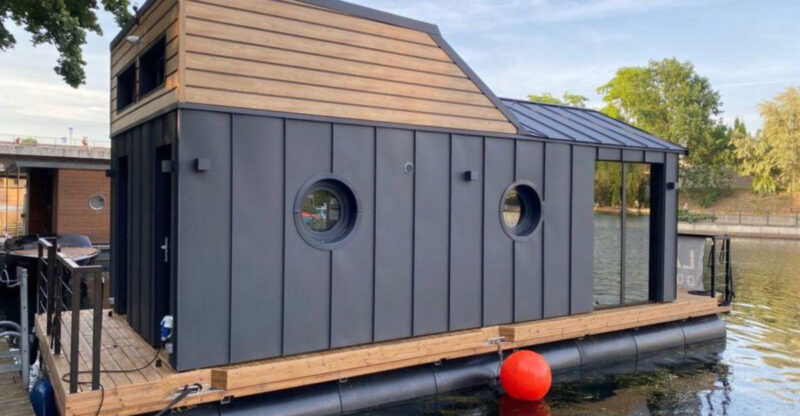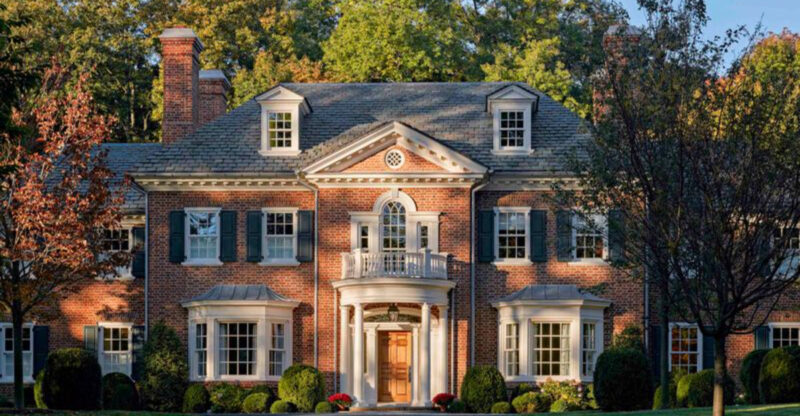25 Secluded Mansions In Maine With Unforgettable Settings
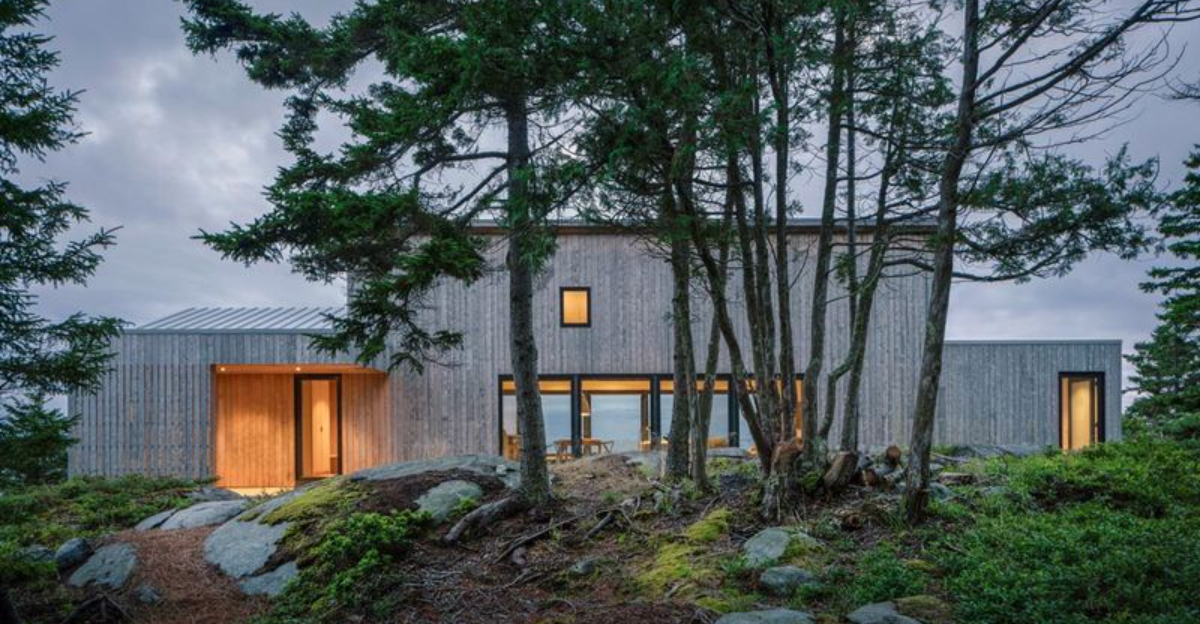
Maine’s rugged coastline and dense forests hide some of America’s most spectacular private residences.
From historic estates perched on rocky cliffs to modern architectural marvels nestled among pine trees, these secluded mansions offer glimpses into extraordinary living spaces with breathtaking natural surroundings.
Let me take you on a journey through Maine’s most magnificent hidden homes where luxury meets wilderness in perfect harmony.
1. Victoria Mansion, Portland
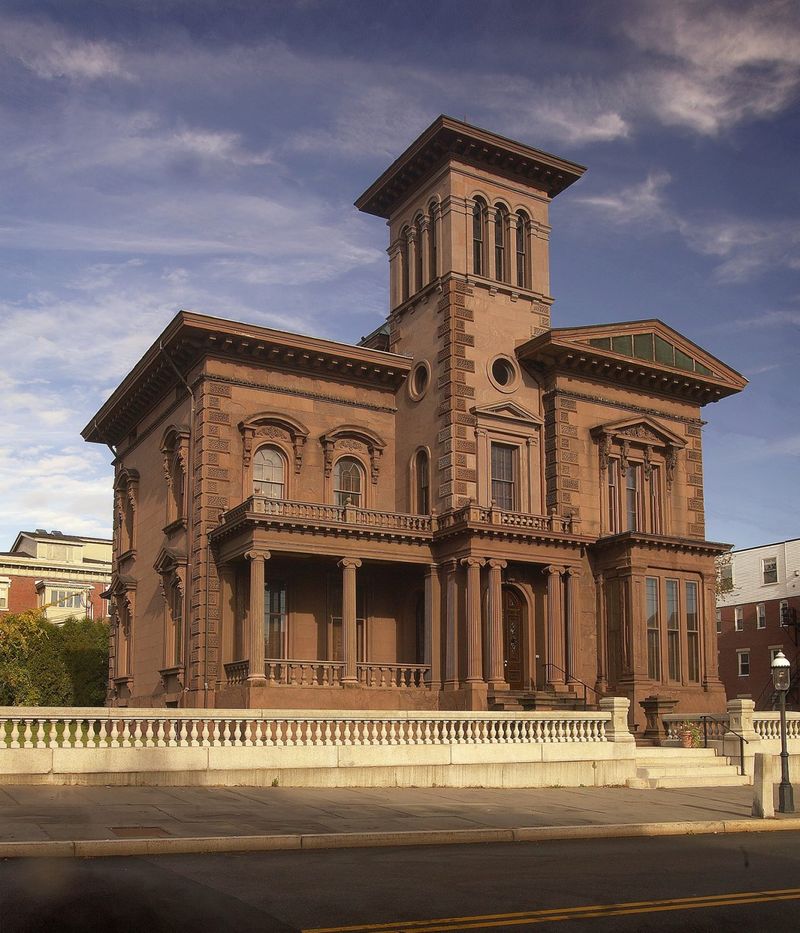
Standing proudly since 1860, this brownstone Italian villa-style mansion showcases opulent Victorian design at its finest. The interior features hand-painted walls, carved woodwork, and stained glass that transport visitors to a bygone era of elegance.
Summer visitors can explore the meticulously preserved rooms filled with original furnishings and décor. The mansion’s ornate details reflect the wealth of its original owner, hotelier Ruggles Sylvester Morse, who spared no expense in creating this urban retreat.
Despite its downtown Portland location, the property maintains a sense of seclusion with its carefully landscaped grounds shielding it from the bustling city outside. History buffs consider it one of America’s most important Victorian house museums.
2. Hamilton House, South Berwick
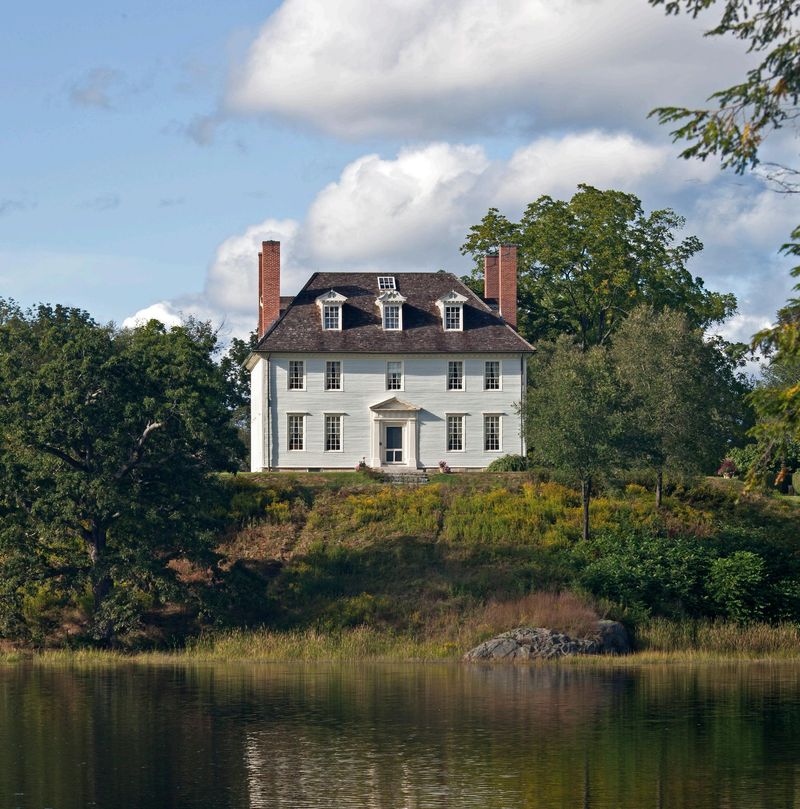
Perched above the Salmon Falls River, Hamilton House represents Georgian elegance at its finest. The 1785 mansion boasts a symmetrical façade with a central doorway framed by decorative pilasters that immediately catches the eye of architectural enthusiasts.
Visitors wander through Colonial Revival gardens designed by the Tysons, who purchased and restored the property in the early 1900s. Inside, period furnishings and decorative arts showcase the refined taste of wealthy shipping merchants who once called this riverside estate home.
Though just minutes from town, the property’s location on a gentle rise creates a private world unto itself. The sweeping river views and peaceful gardens make it easy to understand why writer Sarah Orne Jewett featured this enchanting setting in her stories.
3. Beckett’s Castle, Cape Elizabeth
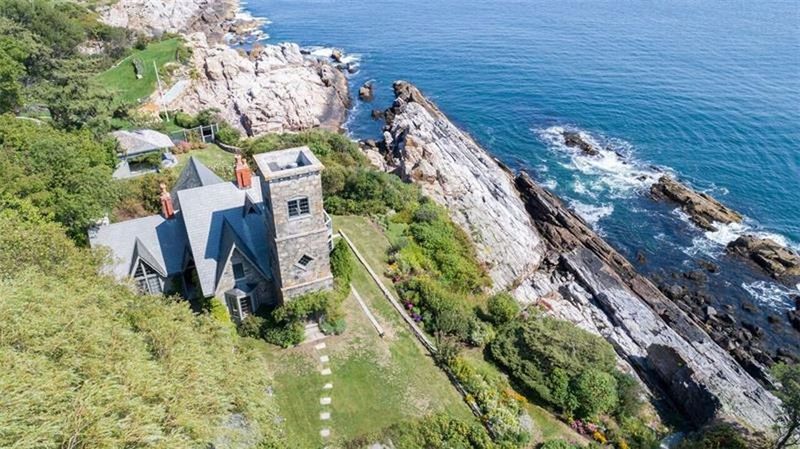
If walls could talk, Beckett’s Castle would tell tales of literary gatherings and rumored paranormal encounters. Built in 1874 by renowned Portland lawyer Sylvester Beckett, this Gothic Revival stone cottage features a distinctive square tower that stands out against Cape Elizabeth’s coastal landscape.
The castle’s stone exterior, quarried from nearby ledges, gives it a medieval appearance that contrasts beautifully with the surrounding maritime scenery. Inside, hand-carved woodwork and period details reflect Beckett’s eclectic tastes and his love of European architectural styles.
Hidden among trees just a stone’s throw from the crashing Atlantic waves, the property offers seclusion while maintaining dramatic ocean views. Local legends claim Beckett’s spirit still roams the grounds, making it a favorite among those fascinated by Maine’s haunted history.
4. Drexel Estate (Gripsholm Manor), Islesboro
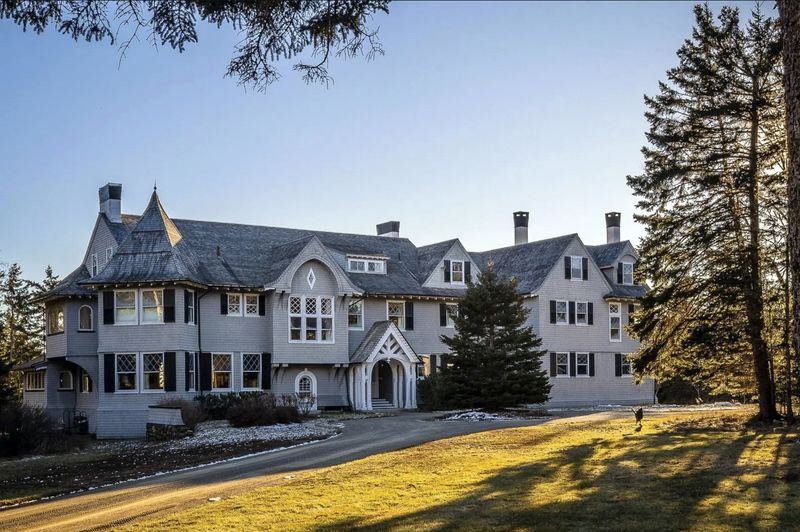
Accessible only by boat, this magnificent Tudor-style summer cottage represents the grandeur of Maine’s island retreats. Built for financier George Drexel in the early 1900s, the estate sprawls across several acres of prime Islesboro waterfront, offering panoramic views of Penobscot Bay.
Massive stone fireplaces and exposed timber beams dominate the interior spaces, while leaded glass windows frame perfect vignettes of the surrounding landscape. The property includes extensive gardens, a private dock, and several outbuildings that once housed staff serving the wealthy Philadelphia family during their summer sojourns.
Though rarely open to the public, glimpses of this secluded manor from passing boats reveal why Maine’s islands became the playground for America’s industrial elite. The mansion stands as a testament to an era when wealthy families escaped city heat by retreating to Maine’s cooler coastal climate.
5. Mosquito Island House, St. George
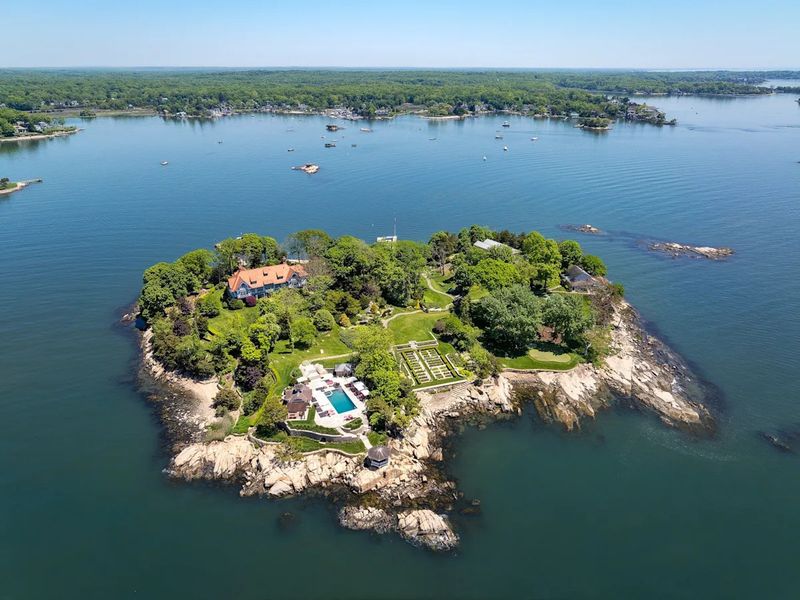
Shrouded in mystery and protected by private ownership, this contemporary masterpiece sits on its own 216-acre island off the St. George peninsula. The main residence, designed by a renowned architect, blends seamlessly with the rugged granite shoreline through its use of natural materials and floor-to-ceiling windows.
Solar panels and other sustainable features make this compound nearly self-sufficient despite its luxury appointments. Multiple guest houses, a boathouse, and a deep-water dock complete this exclusive retreat where privacy is guaranteed by the surrounding waters of Muscongus Bay.
Owned by a tech billionaire who values seclusion, the property remains one of Maine’s most exclusive private residences. Few have seen beyond the carefully guarded shoreline, though aerial photographs occasionally offer glimpses of this extraordinary island estate that represents modern Maine luxury at its most exclusive.
6. Frederick Law Olmsted Summer Home (Felsted), Deer Isle
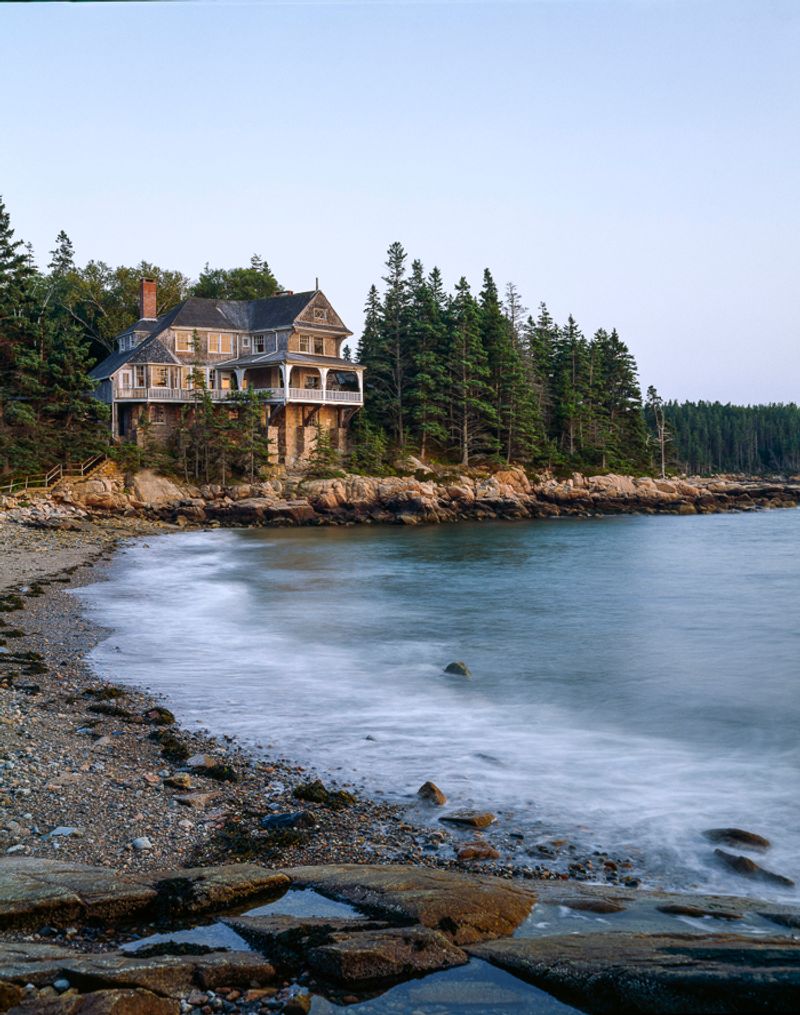
Hidden among towering pines on Deer Isle’s rocky shore sits the former summer retreat of America’s most famous landscape architect. Olmsted, who designed Central Park and countless other iconic spaces, chose this remote location for its natural beauty and isolation from his busy professional life.
The shingled cottage exemplifies the understated elegance of early Maine summer homes, with wide porches positioned to capture cooling sea breezes and spectacular sunset views. Inside, simple woodwork and built-in furniture reflect the Arts and Crafts influence popular during the home’s construction in the late 1800s.
What makes this property truly special is how Olmsted applied his landscape genius to the surrounding grounds. He carefully preserved natural features while subtly enhancing views and creating intimate outdoor rooms defined by native plantings. The property demonstrates how architecture can complement rather than compete with Maine’s natural beauty.
7. Lady Pepperrell House, Kittery Point
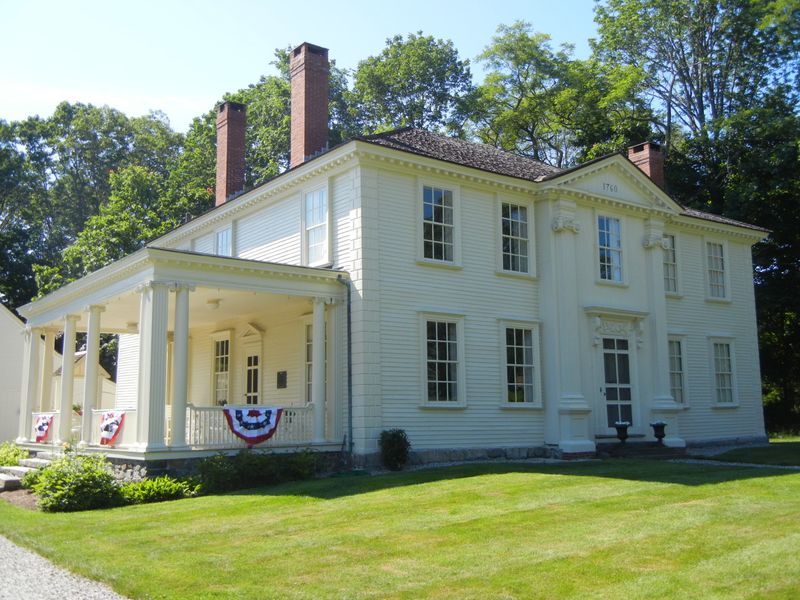
Graceful Georgian symmetry defines this 1760 mansion built by the widow of Sir William Pepperrell, once the wealthiest man in colonial Maine. The imposing central doorway with its elaborate pediment announces the home’s importance before visitors even step inside.
Hand-carved wainscoting and corner cupboards showcase the craftsmanship available to the colonial elite. Each spacious room features tall windows that flood the interior with natural light while offering views of the Portsmouth Harbor that brought the Pepperrell family their shipping fortune.
Though surrounded today by other historic homes, the mansion’s generous grounds and prominent position maintain its aura of distinction. The property stands as a remarkable example of pre-Revolutionary War architecture in Maine, preserved largely as it would have appeared when Lady Pepperrell entertained the colonial society of her day.
8. Skylands (Martha Stewart Estate), Mount Desert Island
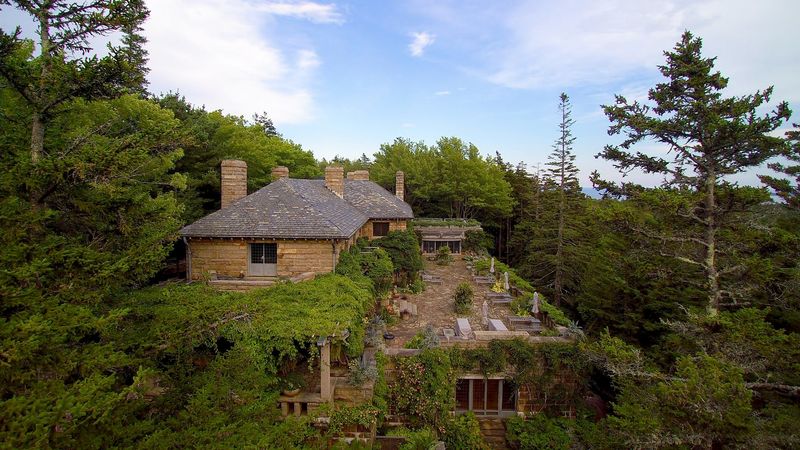
Carved from local pink granite, this 1925 summer estate exemplifies the grand scale of Mount Desert Island’s cottage era. Martha Stewart purchased and meticulously restored this 12-bedroom Edwardian mansion, preserving its original character while updating it for modern living.
Terraced gardens designed by landscape pioneer Jens Jensen cascade down to the shoreline, creating outdoor rooms that frame views of Seal Harbor. Inside, Stewart maintained the home’s original fittings, including brass hardware, leaded glass windows, and vintage bathroom fixtures that speak to its period authenticity.
Despite its 63-acre grounds offering ultimate privacy, the mansion sits just minutes from Acadia National Park. Stewart’s careful stewardship has made this property a showcase for historic preservation, demonstrating how Maine’s grand summer cottages can be respectfully maintained for future generations while accommodating contemporary lifestyles.
9. Castle Tucker, Wiscasset
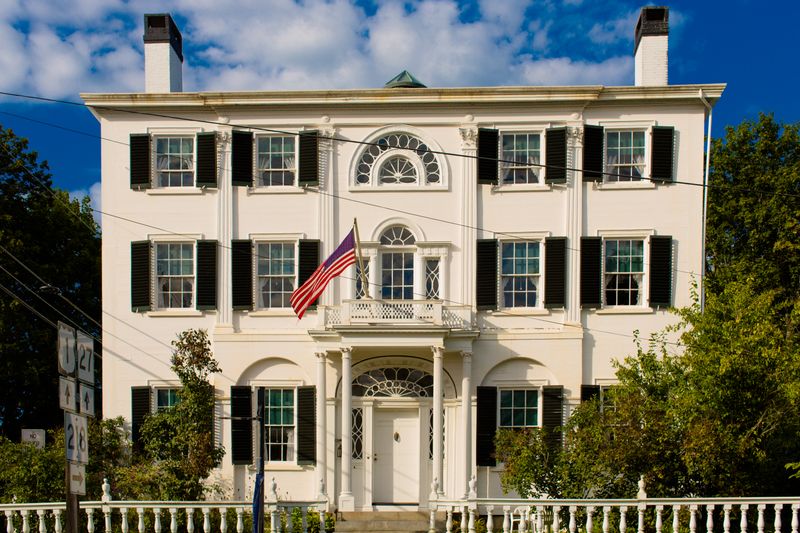
Commanding views over the Sheepscot River have made this Federal-style mansion a landmark since 1807. Its most distinctive feature, a two-story elliptical portico, creates a grand entrance that signals the home’s importance in this historic shipping town.
Unlike many historic houses that display idealized period rooms, Castle Tucker preserves the authentic lived-in quality of the Tucker family, who occupied it for over 150 years. Victorian furnishings, family photographs, and everyday objects tell the story of a once-wealthy family adapting to changing fortunes while maintaining their ancestral home.
Though located in the heart of Wiscasset village, the property’s elevated position and surrounding gardens create a sense of private sanctuary. Visitors experience the genuine atmosphere of a grand Maine home that evolved with its family rather than a museum-perfect restoration, making it uniquely relatable despite its impressive architecture.
10. Nickels-Sortwell House, Wiscasset
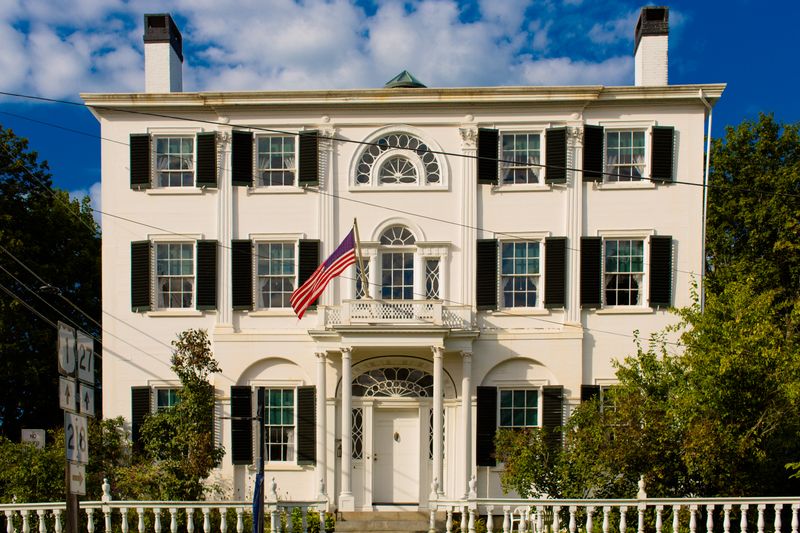
Rising three stories above Wiscasset’s Main Street, this Federal masterpiece showcases the prosperity of early 19th-century shipbuilders. Constructed in 1807 by sea captain William Nickels, the brick mansion features an elaborate fanlight over the front door and delicate Adamesque details that reflect the refined taste of New England’s maritime elite.
The flying staircase in the central hallway creates a dramatic first impression with its graceful curves and minimal visible support. Later owners, the Sortwell family, added Colonial Revival touches during their early 1900s restoration, creating interiors that blend Federal elegance with early 20th-century interpretations of historic style.
A hidden garden behind the house offers a secluded retreat from the tourist-filled streets of Wiscasset. The property stands as a testament to Maine’s shipbuilding wealth and the early preservation movement that saved many of the state’s architectural treasures.
11. Sarah Orne Jewett House, South Berwick
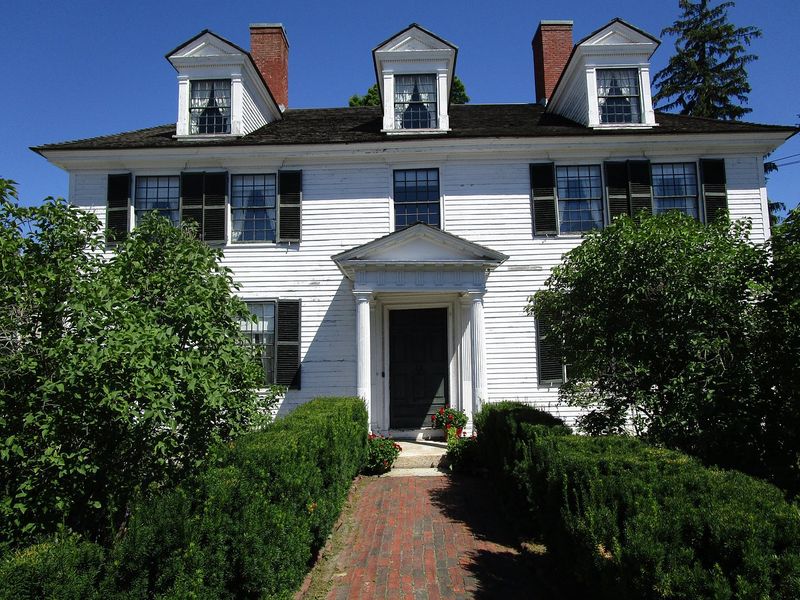
Literary history permeates this stately Georgian home where acclaimed author Sarah Orne Jewett crafted stories celebrating Maine’s coastal communities. Built in 1774 by her grandfather, the house combines Federal and Georgian architectural elements with an elegant portico that distinguishes it from neighboring homes.
Jewett’s second-floor writing desk remains positioned by the window where she observed town life and found inspiration for her characters. Her carefully preserved library contains first editions of her works alongside books from literary friends like Willa Cather and Annie Fields who visited this intellectual haven.
Though centrally located in South Berwick, tall hedges and mature trees create a private sanctuary where Jewett could write undisturbed. The home offers visitors rare insight into the domestic life of one of America’s most important regional authors, whose detailed portrayals of Maine coastal life preserved a vanishing culture for future generations.
12. Heritage Hall, Belfast
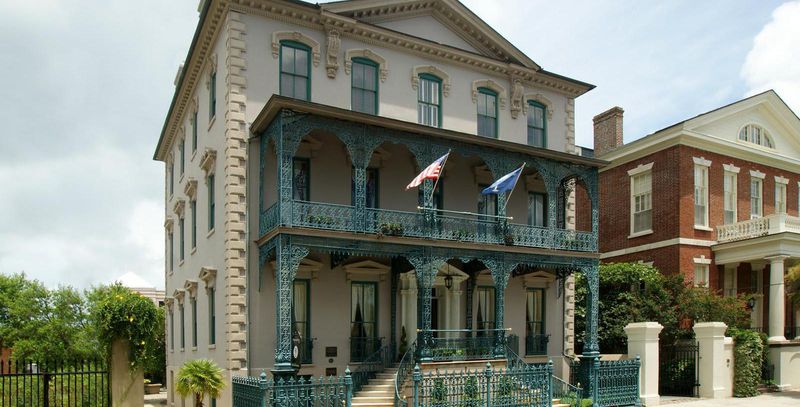
Gilded Age grandeur defines this Italianate mansion overlooking Belfast Harbor. Built in 1879 by a prosperous shipbuilder, the home features elaborate bracketed cornices, bay windows, and a distinctive cupola that once served as a lookout for ships returning to port.
The interior showcases hand-painted ceilings, marble fireplaces, and walnut woodwork that reflect Victorian opulence at its height. A three-story spiral staircase serves as the centerpiece of the home, illuminated by a stained glass skylight that bathes the space in colored light.
Situated on a hill above downtown Belfast, the mansion’s grounds offer privacy while maintaining views of the busy harbor below. After decades as a private residence, the home now occasionally opens for special events, allowing glimpses into Maine’s maritime prosperity when shipbuilding brought tremendous wealth to coastal communities like Belfast.
13. Sayward-Wheeler House, York Harbor
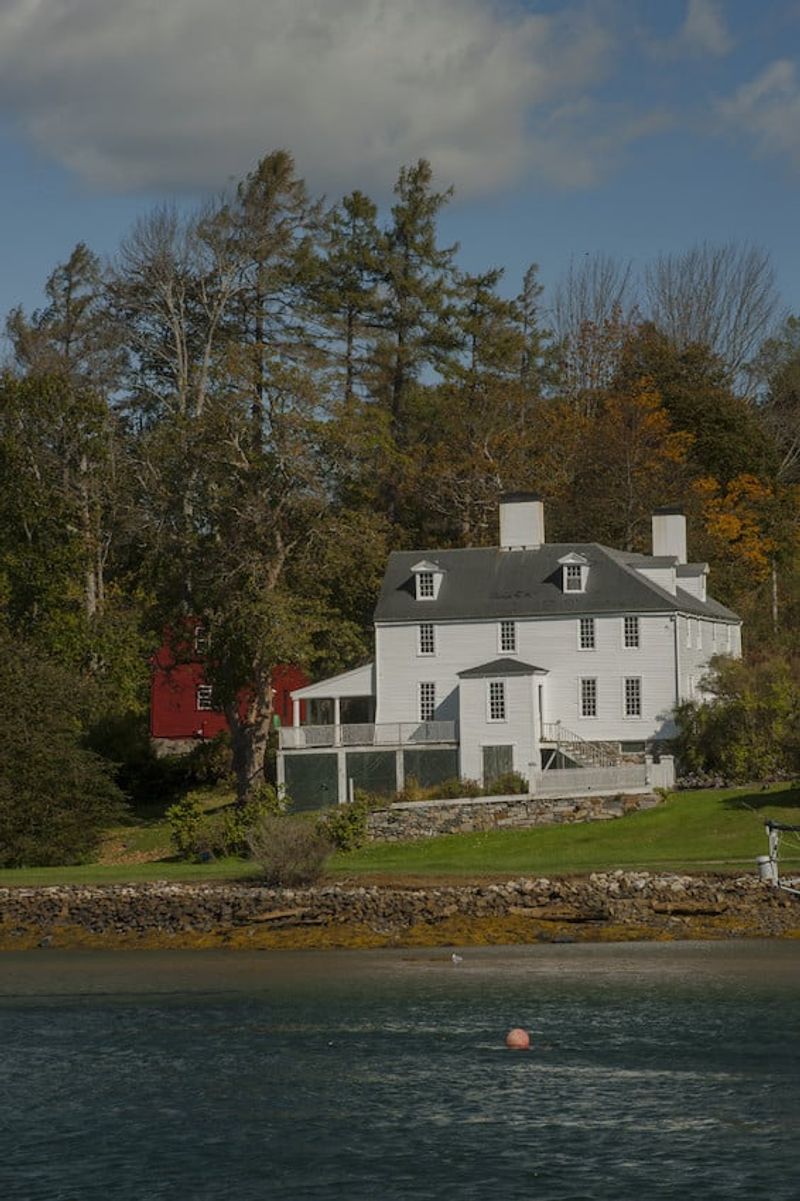
Modest by mansion standards, this 1718 colonial home compensates with authentic period details and spectacular water views. Occupied by the same family for over 240 years, the house contains an extraordinary collection of original furnishings, including rare examples of early American decorative arts rarely seen outside museums.
Low ceilings with exposed beams, wide-plank pine floors, and simple paneling reflect the practical elegance of colonial architecture. The home’s position on a bluff overlooking York Harbor provided the merchant Sayward family with clear views of approaching ships carrying goods for their trading business.
Despite development in surrounding York Harbor, the property maintains its historic isolation through careful preservation of its grounds. Visitors experience one of Maine’s most authentic colonial homes, where generations of a single family accumulated possessions rather than curators assembling period collections.
14. Eastport Sea Captain’s Homes, Eastport
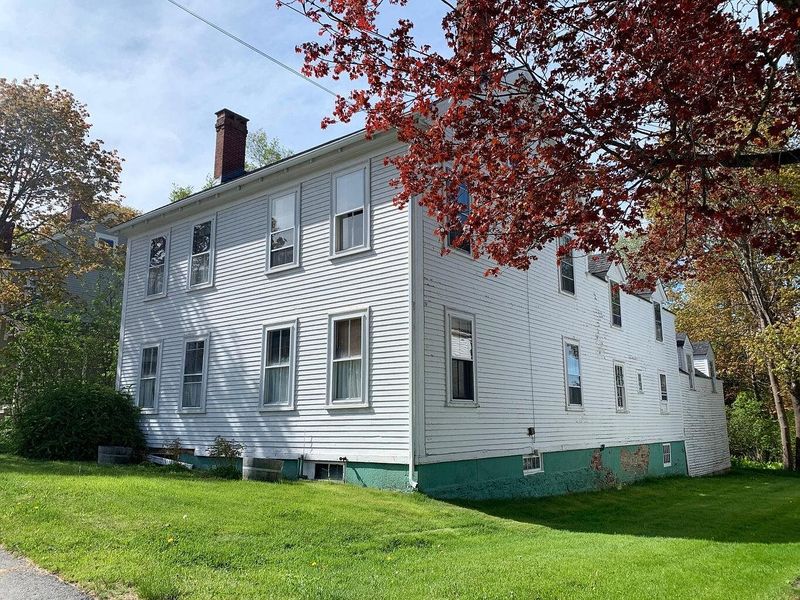
At America’s easternmost city, a collection of Federal and Greek Revival mansions lines Water Street, creating one of Maine’s most impressive historic districts. These homes, built by prosperous sea captains and merchants during Eastport’s 19th-century shipping boom, feature widow’s walks, elaborate entrance porticos, and maritime details that reflect their owners’ seafaring backgrounds.
Many interiors retain original features like curved stairways, carved fireplace mantels, and built-in china cabinets displaying generations of family treasures. Large windows frame dramatic views of Passamaquoddy Bay, where these captains once watched for their returning ships.
Though technically part of a small city, Eastport’s remote location at the edge of Maine creates a sense of isolation. These magnificent homes represent the surprising prosperity that maritime trade brought to even the most distant corners of Maine, where fortunate captains built mansions worthy of much larger cities.
15. Oldfields Estate, Bar Harbor
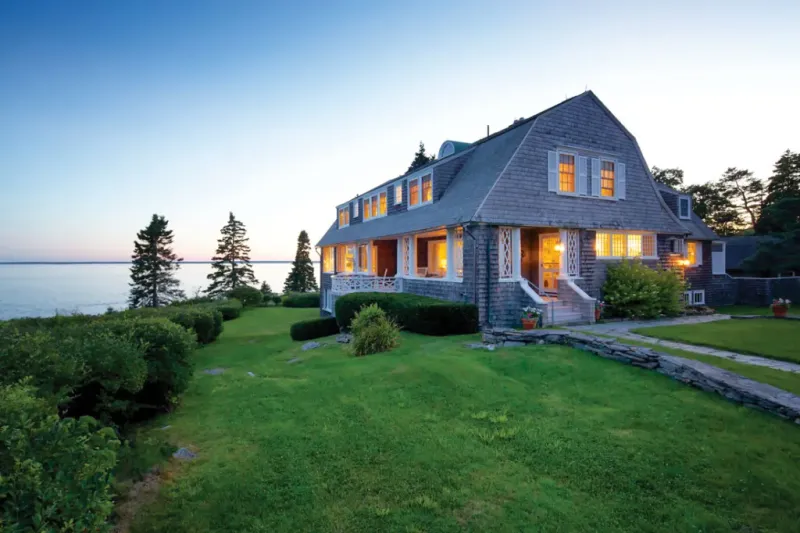
Hidden behind iron gates, this stone mansion represents the second wave of Bar Harbor’s cottage era when Beaux-Arts grandeur replaced earlier wooden summer homes. Constructed in 1906 for a Philadelphia banking family, the estate features formal gardens, a saltwater swimming pool carved from natural rock, and a private beach accessible only through the property.
Unlike the ostentatious cottages of some summer residents, Oldfields embraces a more restrained elegance with clean architectural lines and locally quarried granite that helps it blend with Mount Desert Island’s natural landscape. The interior combines European antiques with American craftsmanship in a style that defined Bar Harbor’s golden age.
Though many neighboring estates were destroyed in the devastating 1947 fire, Oldfields survived to represent Bar Harbor’s glory days. The mansion remains a private residence, glimpsed only occasionally when its gardens open for select charity events.
16. Kennebunkport Retreat, Kennebunkport
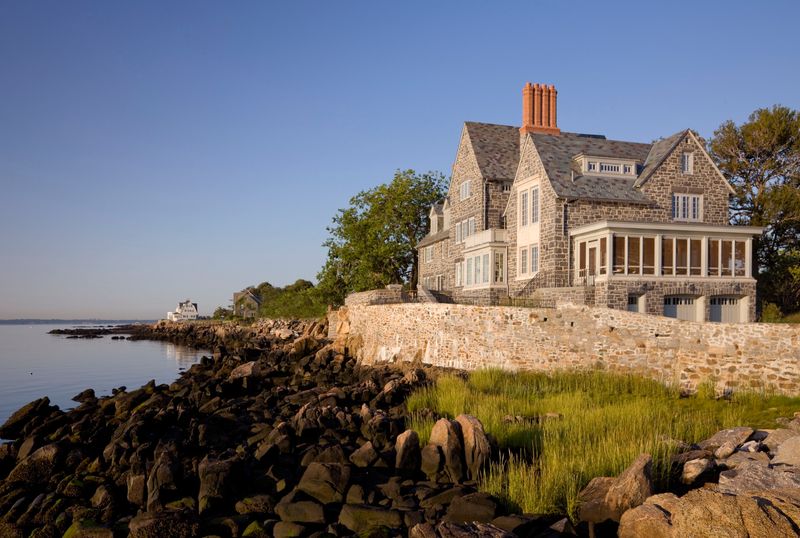
Shingle Style architecture reaches its pinnacle at this oceanfront compound nestled on a rocky peninsula. Built in the 1890s and extensively renovated by its current owners, the property combines historic character with modern luxuries while maintaining the rustic elegance that defines Maine’s most desirable coastal homes.
Multiple gables, asymmetrical rooflines, and natural cedar shingles weathered to a silvery gray help the sprawling structure settle harmoniously into its surroundings. Floor-to-ceiling windows in the main living spaces frame dramatic Atlantic views, while stone terraces extend living areas outdoors during summer months.
A private deep-water dock accommodates the owner’s vintage wooden yacht. Though neighboring properties dot the peninsula, careful landscaping with native plants creates natural screening that preserves privacy without blocking ocean vistas, demonstrating why Kennebunkport remains a retreat for those seeking sophisticated coastal living.
17. Camden Cliffside Estate, Camden
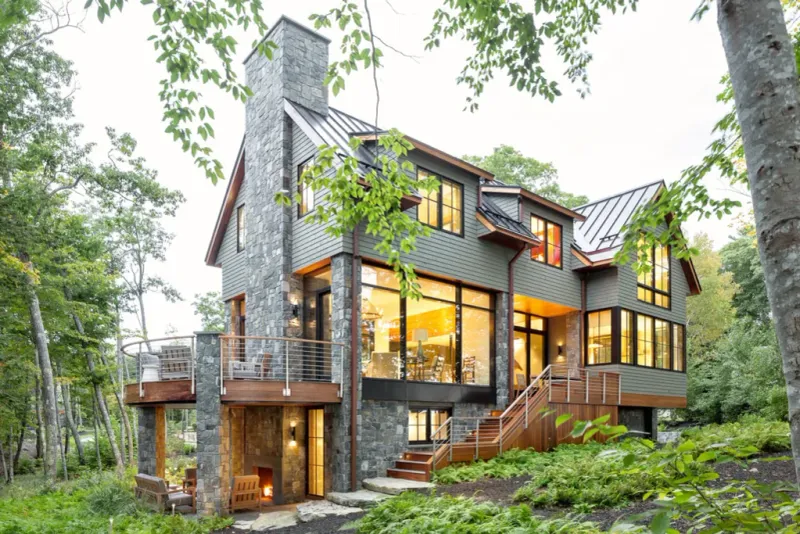
Defying gravity, this contemporary glass and steel masterpiece clings to a granite cliff overlooking Penobscot Bay. Designed by an award-winning architect for a privacy-seeking tech entrepreneur, the home features cantilevered living spaces that appear to float above the crashing waves below.
Minimalist interiors focus attention on the panoramic water views visible through walls of glass that blur the boundary between indoors and nature. Sustainable design elements include geothermal heating, solar panels, and rainwater collection systems that minimize the property’s environmental footprint despite its luxury appointments.
A private funicular railway connects the cliff-top residence to a protected cove with a boat dock. Though visible from the water, the estate remains inaccessible by land except through a gated entrance, representing a new generation of Maine coastal retreats where contemporary design meets environmental consciousness.
18. Portland’s Hidden Gem, Portland
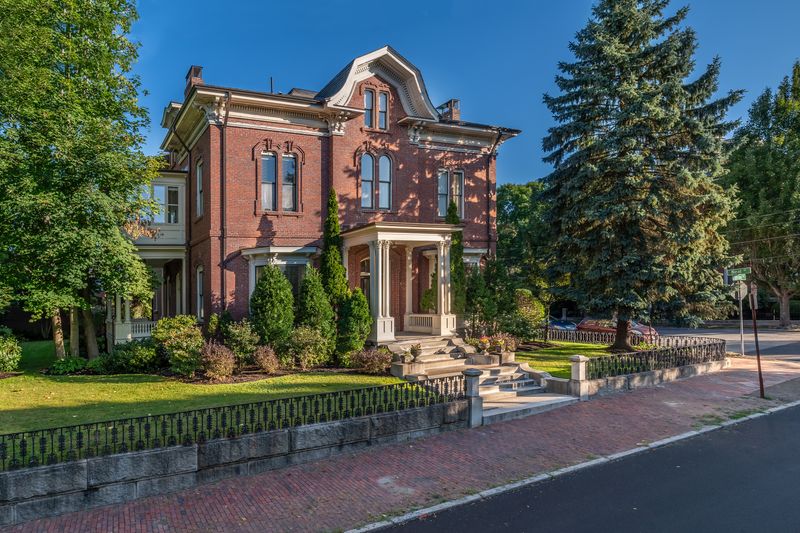
Concealed behind brick walls in Portland’s historic West End neighborhood, this Italianate mansion surprises visitors with its expansive grounds rarely found in urban settings. Built in 1863 for a lumber baron, the home features ornate plasterwork, marble fireplaces, and a spectacular three-story central staircase topped by a stained glass skylight.
The current owners have carefully balanced historic preservation with contemporary comfort, maintaining original architectural details while updating systems and adding a glass-walled kitchen extension that overlooks the formal gardens. The property includes a carriage house converted to guest quarters and a hidden swimming pool sheltered by mature maple trees.
Despite its downtown location just steps from Portland’s vibrant restaurant scene, the estate offers complete privacy behind its historic walls. This urban oasis demonstrates how Maine’s wealthy industrialists created secluded compounds even within city limits.
19. Katahdin Lodge, Millinocket region
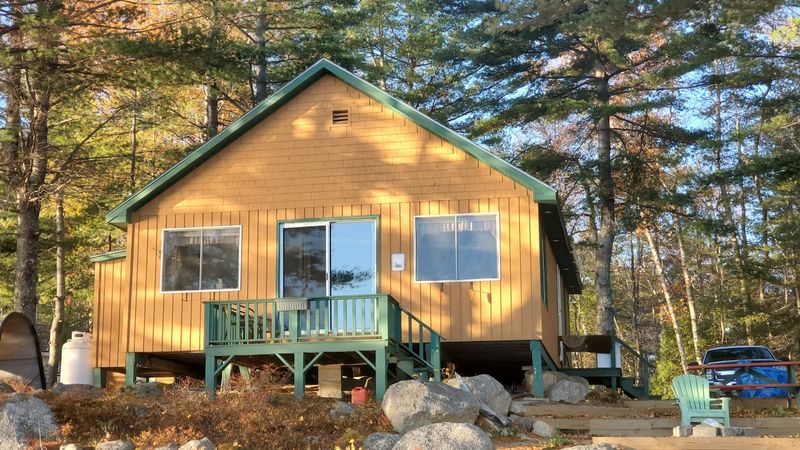
Timber frame construction reaches artistic heights at this wilderness compound overlooking Mount Katahdin. Built by a lumber family in the 1930s and recently expanded, the lodge combines rustic materials with sophisticated design to create a retreat that honors Maine’s logging heritage.
Massive pine beams, fieldstone fireplaces, and locally harvested cedar paneling create interiors that smell of the forest. Floor-to-ceiling windows in the great room frame perfect views of Maine’s highest peak, while screened porches provide bug-free outdoor living during summer months.
The 300-acre property includes private trout ponds, hiking trails, and wildlife observation blinds where residents can photograph the moose that frequent the area. This secluded compound represents the Maine wilderness retreat at its most refined, offering luxury accommodations in a setting that feels untouched by civilization despite being just an hour from Bangor.
20. Acadia National Park Residence, Bar Harbor area
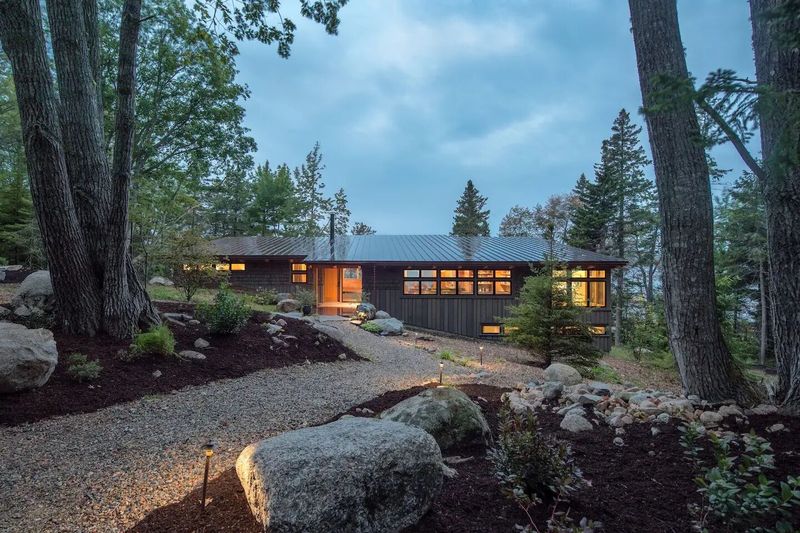
Nestled between Acadia National Park boundaries and the Atlantic Ocean, this contemporary interpretation of traditional Maine architecture demonstrates how new construction can honor regional building traditions. Designed by a noted Maine architect, the residence uses native granite, cedar shingles, and copper roofing that will develop a natural patina matching the surrounding landscape.
The U-shaped floor plan creates a sheltered courtyard facing the water, while floor-to-ceiling windows capture views of Cadillac Mountain and Frenchman Bay. Interiors feature handcrafted furniture from Maine artisans and an impressive collection of regional art that celebrates the area’s natural beauty.
Though surrounded by one of America’s most visited national parks, careful site selection and natural screening maintain complete privacy. This remarkable property shows how thoughtful design can create a secluded retreat even in an area known for tourism.
21. Moosehead Lake Manor, Greenville area
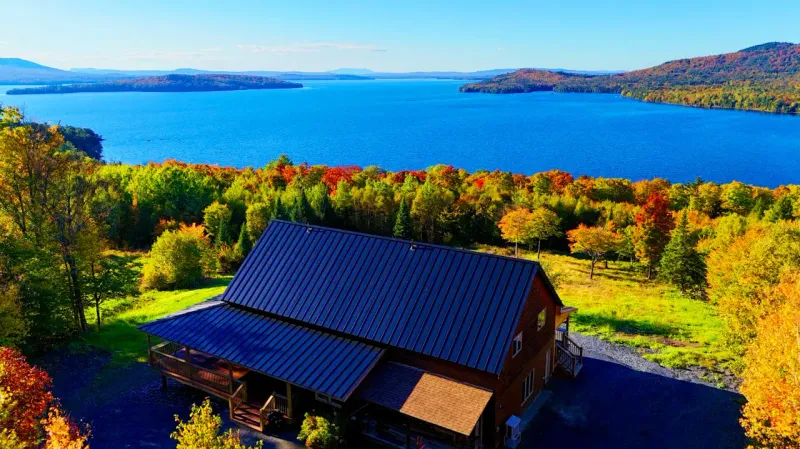
Log construction achieves unprecedented sophistication at this 15,000-square-foot lodge overlooking Maine’s largest lake. Hand-hewn Eastern white pine logs, some measuring three feet in diameter, create walls of extraordinary thickness that maintain comfortable temperatures regardless of season.
A great room dominated by a massive stone fireplace features a soaring 30-foot ceiling supported by trusses crafted from whole trees. Floor-to-ceiling windows showcase panoramic views of Moosehead Lake and distant mountains, while a wraparound deck extends living space outdoors during warmer months.
The 100-acre property includes a private boat harbor, seaplane dock, and network of hiking trails. Despite its impressive scale, the residence maintains a harmonious relationship with its natural setting through careful siting and the use of native materials, representing the ultimate North Woods retreat for those seeking luxury in Maine’s remote interior.
22. West Quoddy Head Light Mansion, Lubec
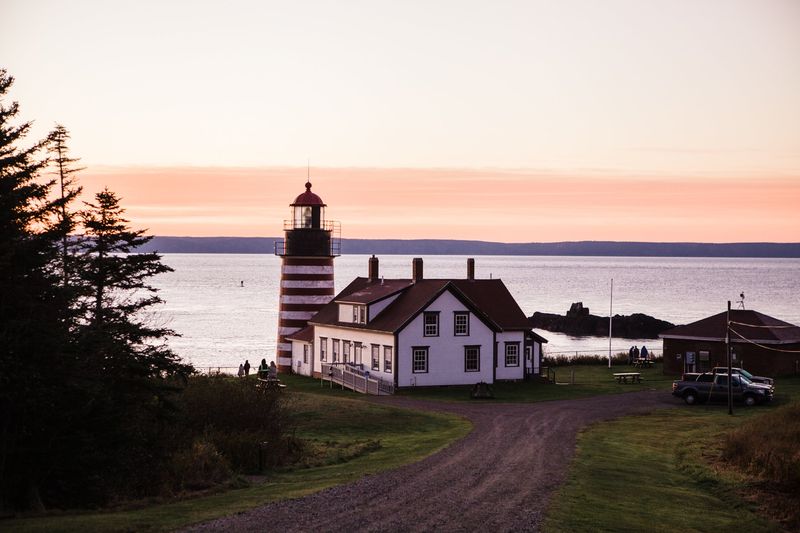
America’s easternmost mansion sits adjacent to the iconic striped lighthouse at the country’s easternmost point. Built in the 1820s for the original lighthouse keeper and expanded over generations, this Federal-style residence offers views extending to Canada’s Grand Manan Island across the Bay of Fundy.
The current owners meticulously restored the historic structure while adding modern amenities that respect its architectural heritage. Original wide-plank floors, six working fireplaces, and hand-blown glass windows maintain the home’s authentic character despite contemporary updates to the kitchen and bathrooms.
Fog-shrouded and remote, the property epitomizes the rugged isolation that defines Down East Maine. This remarkable residence allows its occupants to experience life at America’s eastern edge, where the sun first touches United States soil each morning and powerful Bay of Fundy tides create dramatic shoreline transformations.
23. Former Dance Hall Harborfront Retreat, Southwest Harbor
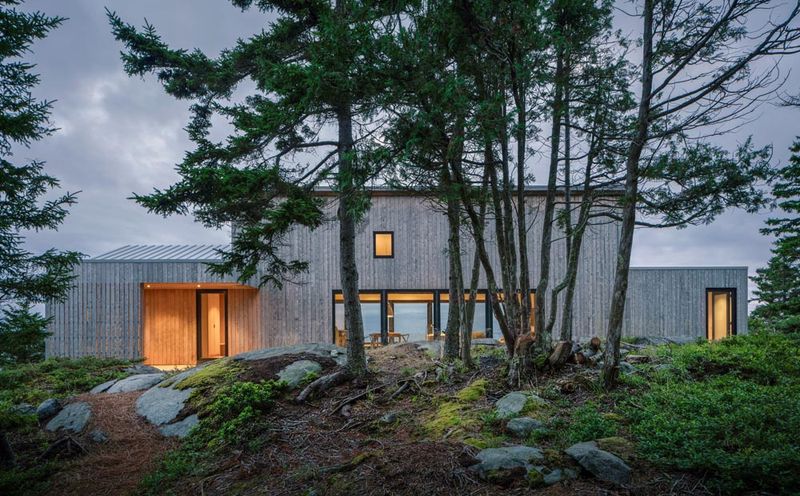
Creative adaptive reuse transformed this 1900s dance pavilion into one of Mount Desert Island’s most distinctive waterfront homes. The octagonal main living area, originally designed for dancing, now serves as a spectacular great room with 270-degree views of Southwest Harbor through a series of French doors that open to a wraparound deck.
The current owners preserved the building’s unique character while adding modern amenities, including a professional kitchen and spa-like bathrooms. Original maple dance floors, exposed ceiling beams, and period light fixtures maintain connections to the structure’s entertaining past.
A private dock provides direct access to some of Maine’s best sailing waters. Though just minutes from Acadia National Park, the property’s position on a small peninsula creates a sense of isolation despite being within walking distance of Southwest Harbor’s village center.
24. Friendship Seaside Estate, Friendship

Lobster boats replacing mega-yachts provide the authentic maritime backdrop for this understated coastal compound in the working harbor town of Friendship. The main house, a restored 1870s sea captain’s residence, features a widow’s walk offering panoramic views of Muscongus Bay and its scattering of pine-covered islands.
Unlike showier coastal mansions, this property embraces Maine’s maritime heritage with simple, elegant architecture and interiors that showcase local craftsmanship. Hand-built furniture from nearby Shaker communities, hooked rugs depicting coastal scenes, and maritime paintings by local artists create a distinctly Maine aesthetic.
The 12-acre waterfront property includes several guest cottages, a deepwater dock, and protected woodland. This remarkable estate offers seclusion without isolation in a community where working lobster boats far outnumber pleasure craft, representing Maine coastal living at its most authentic.
25. Mimosa Hall, Thomaston

Federal architecture reaches its zenith at this magnificent 1810 mansion built by General Henry Knox’s daughter and son-in-law. The perfectly proportioned brick residence features a distinctive monitor roof, elliptical fanlight over the front door, and delicate wooden balustrades that exemplify the refined taste of early 19th-century New England aristocracy.
Inside, elaborate plaster cornices, marble fireplaces, and an elliptical staircase showcase the craftsmanship available to wealthy families in Maine’s post-Revolutionary period. The current owners have maintained period authenticity while carefully incorporating modern systems that don’t detract from the home’s historic character.
Set back from Thomaston’s main street behind mature maple trees, the mansion maintains privacy despite its in-town location. This architectural masterpiece represents the sophisticated taste and prosperity of Maine’s early shipping magnates, whose fortunes built homes rivaling those in larger coastal cities.

